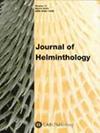Immune responses of the argasid tick Ornithodoros moubata moubata induced by infection with the filarial worm Acanthocheilonema viteae
IF 1.3
3区 生物学
Q4 PARASITOLOGY
引用次数: 0
Abstract
Investigations were undertaken to determine whether the tick丝虫Acanthocheilonema viteae感染箭蜱Ornithodoros moubata moubata引起的免疫反应
研究的目的是确定蜱Ornithodoros moubatamoubata是否会对Acanthocheilonema viteae的初次和继发感染产生可检测到的免疫反应。未感染对照组蜱的存活率为 70%,而初次感染组仅为 45%。二次感染后的存活率(82%)与对照组相当,表明这些被选中的蜱具有一定的保护优势。从二次感染的蜱虫中恢复的平均虫体幼虫感染率比预期的低 31.4%,这表明蜱虫已经产生了免疫力。对初次感染后诱导蛋白质的血淋巴进行 SDS-PAGE 分析,发现 45 kDa 的信号比对照组强,二次感染后进一步升高。在受感染蜱的血淋巴中检测到了 48、22 和 16 至 18 kDa 蛋白质,而对照组中则没有检测到。血淋巴对微丝蚴存活率的直接影响是使用一种新型体外检测方法进行检测的;在这些初步试验中,当暴露于感染或未感染蜱群的血淋巴中时,寄生虫存活率没有差异。
本文章由计算机程序翻译,如有差异,请以英文原文为准。
求助全文
约1分钟内获得全文
求助全文
来源期刊

Journal of Helminthology
生物-动物学
CiteScore
2.80
自引率
12.50%
发文量
127
审稿时长
3 months
期刊介绍:
Journal of Helminthology publishes original papers and review articles on all aspects of pure and applied helminthology, particularly those helminth parasites of environmental health, medical or veterinary importance. Research papers on helminths in wildlife hosts, including plant and insect parasites, are also published along with taxonomic papers contributing to the systematics of a group. The journal will be of interest to academics and researchers involved in the fields of human and veterinary parasitology, public health, microbiology, ecology and biochemistry.
 求助内容:
求助内容: 应助结果提醒方式:
应助结果提醒方式:


